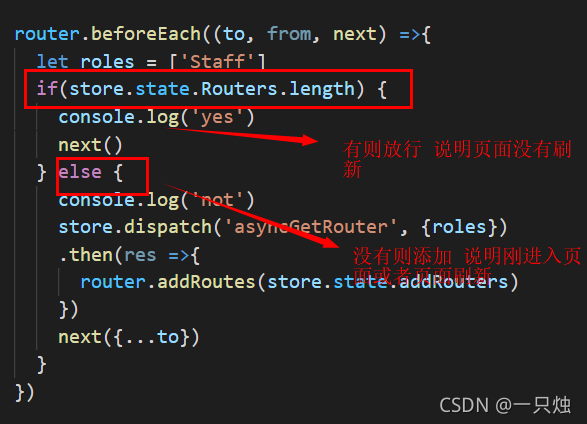根据用户的权限,展示不同的菜单页。
知识点路由守卫(使用了前置守卫):根据用户角色判断要添加的路由
vuex:保存动态添加的路由
每次路由发生变化时都需要调用一次路由守卫,并且store中的数据会在每次刷新的时候清空,因此需要判断store中是否有添加的动态路由。
(若没有判断 则会一直添加 导致内存溢出)

根据角色判断路由
过滤动态路由 判断每条路由角色是否与登录传入的角色一致

<template> <div> <el-menu :default-active="$route.path" background-color="#324057" text-color="white" active-text-color="#20a0ff" :collapse="isCollapse" unique-opened router > <el-submenu v-for="item in $store.state.Routers" :key="item.path" :index="item.path" v-if="!item.hidden" > <template slot="title" > <i></i> <span>{{ item.meta.title }}</span> </template> <div v-for="chi in item.children" :key="chi.name"> <el-menu-item v-if="!chi.hidden" :index="item.path + 'https://www.jb51.net/' + chi.path"> <i></i>{{ chi.meta.title }} </el-menu-item> </div> </el-submenu> </el-menu> </div> </template> <script> export default { name: "MenuList", data() { return { isCollapse: false, }; }, created() { this.$bus.$on("getColl", (data) => { this.isCollapse = data; }); }, methods: { } }; </script> <style scoped> .menu_wrap { height: 100vh; } .el-menu-vertical-demo:not(.el-menu--collapse) { width: 200px; height: 100vh; } </style>
import Vue from 'vue' import VueRouter from 'vue-router' import store from '../store/index' Vue.use(VueRouter) const originalPush = VueRouter.prototype.push VueRouter.prototype.push = function push(location) { return originalPush.call(this, location).catch(err => err) } export const routes = [ { path: '/home', name: 'First', component: () => import('../views/Index.vue'), meta: { title: 'Home'}, children: [ { path: 'index', name: 'Home', component: () => import('../views/Home'), meta: { title: 'Home', roles: ['Customer'] } } ] }, { path: '/index', name: 'NavigationOne', component: () => import('../views/Index.vue'), meta: { title: '导航一'}, children: [ { path: 'personnel', name: 'Personnel ', component: () => import('../views/One/Personnel.vue'), meta: { title: 'Personnel', roles: ['Customer'] } }, { path: 'account', name: 'Account', component: () => import('../views/One/Account.vue'), meta: { title: 'Account', roles: ['Customer'] } }, { path: 'psw', name: 'psw', component: () => import('../views/One/Password.vue'), meta: { title: 'psw', roles: ['Customer'] } } ] }, { path: '/card', name: 'NavigationTwo', component: () => import('../views/Index.vue'), meta: { title: '导航二'}, children: [ { path: 'activity', name: 'Activity ', component: () => import('../views/Three/Activity.vue'), meta: { title: 'Activity', roles: ['Customer'] } }, { path: 'Social', name: 'Social', component: () => import('../views/Three/Social.vue'), meta: { title: 'Social', roles: ['Customer'] } }, { path: 'content', name: 'Content', component: () => import('../views/Three/Content.vue'), meta: { title: 'Content', roles: ['Customer'] } } ] }, { path: '/two', name: 'NavigationThree', component: () => import('../views/Index.vue'), meta: { title: '导航三'}, children: [ { path: 'index', name: 'Two ', component: () => import('../views/Two'), meta: { title: 'Two', roles: ['Customer'] } }] }, { path: '/404', name: 'Error', hidden: true, meta: { title: 'error'}, component: () => import('../views/Error') } ] export const asyncRouter = [ // Agent3 Staff2 { path: '/agent', component: () => import('../views/Index.vue'), name: 'Agent', meta: { title: 'Agent', roles: ['Agent','Staff']}, children: [ { path: 'one', name: 'agentOne', component: () => import('@/views/agent/One'), meta: { title: 'agentOne', roles: ['Agent','Staff'] } }, { path: 'two', name: 'agentTwo', component: () => import('@/views/agent/Two'), meta: { title: 'agentTwo', roles: ['Agent'] } }, { path: 'three', name: 'agentThree', component: () => import('@/views/agent/Three'), meta: { title: 'agentThree', roles: ['Agent','Staff'] } } ] }, // Staff3 { path: '/staff', component: () => import('../views/Index.vue'), name: 'Staff', meta: { title: 'Staff', roles: ['Staff']}, children: [ { path: 'one', name: 'StaffOne', component: () => import('@/views/Staff/One'), meta: { title: 'StaffOne', roles: ['Staff'] } }, { path: 'two', name: 'StaffTwo', component: () => import('@/views/Staff/Two'), meta: { title: 'StaffTwo', roles: ['Staff'] } }, { path: 'three', name: 'StaffThree', component: () => import('@/views/Staff/Three'), meta: { title: 'StaffThree', roles: ['Staff'] } } ] }, { path: '*', redirect: '/404', hidden: true } ] const router = new VueRouter({ routes }) router.beforeEach((to, from, next) =>{ let roles = ['Staff'] if(store.state.Routers.length) { console.log('yes') next() } else { console.log('not') store.dispatch('asyncGetRouter', {roles}) .then(res =>{ router.addRoutes(store.state.addRouters) }) next({...to}) // next()与next({ ...to })的区别:next() 放行 next('/XXX') 无限拦截 } }) export default router

